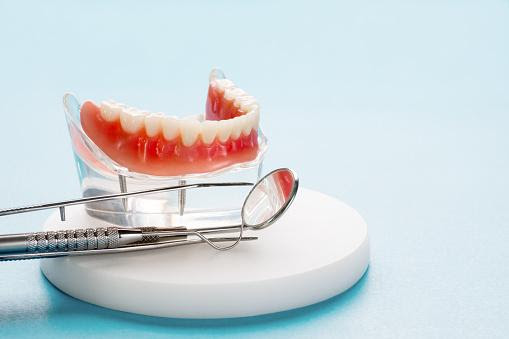TYPES OF DENTURES

There are various kinds of denture accessible. The sort of dental replacement that is best for you relies upon your oral wellbeing status and way of life. The most well-known kinds of dentures include:
Complete Dentures
Complete denture, otherwise called full denture, are removable substitutes for a patient’s whole arrangement of teeth. They are totally alter and re-establish the shape and look of regular teeth. Traditional denture additionally further develop rumination, which implies you can pulverize, pound, and eat food regularly once more. On the off chance that your biting capacities were typical before dental replacement position, the capacities will be considerably less than with regular teeth or Dental Implant.
The absence of port in the bone means you can’t create as much biting power. Numerous patients likewise foster discourse obstacles, like a stutter, with complete denture. This is because of the thickness of the material covering the sense of taste. Certain individuals adjust to it over the long haul, while others don’t. Complete denture are the last choice after any remaining tooth reclamations are considering insufficient.
Dentures don’t forestall bone shrinkage, and in some cases, ineffectively fitting teeth can add to it. Just a Dental Implant will save the bone and keep it from contracting after tooth misfortune.
Fixed Partial Dentures (Implant-Supported Bridge)
Fixed partial dentures (FPD), additionally called implant-supported bridges utilize existing teeth as projections. Projections allude to the encompassing teeth that fill in as the principal support for dental replacement. FPD’s supplant a couple of missing teeth in succession with two dental implants.
In contrast to finish and removable fractional dentures, implant-supported bridges are not removable. These super-durable denture re-establish at least one missing teeth in succession when solid normal teeth are available on the two sides of the missing ones.
Benefits of fixed partial dentures:
- Improved style
- Patients commonly have a sense of safety with fixed (extremely durable) denture
- Stronger than removable dentures
- Consistent tooth situating and better chomp
- Longer insurance of the oral design
Burdens of fixed partial dentures:
- Irreversible substitution of encompassing teeth (projections)
- Abutments are more in danger of rot
- Risk of wounds to the periodontium and dental mash
- Replacement cost is higher than removable denture
Removable Partial Dentures
Not at all like total denture that supplant all teeth, removable partial dentures (RPD) just supplant some missing teeth. An RPD comprises substitution teeth joined to a gum-shaded plastic base. Removable partial dentures are work onto a cast metal structure for strength.
They re-establish the normal look, feel, and capacity of your teeth. RPD’s can be taken out whenever and supplant without any problem. They are most normally suggest for patients who can’t get a dental extension.
There are two sorts of removable partial dentures accessible, including:
- Cast Partial Denture — It is made of tissue-shaded acrylic (gums), substitution teeth, and a metal system that holds the entirety of the materials together. Dental specialists suggest these denture when at least one regular tooth stay in the lower or upper jaw.
- Acrylic Partial Dentures — acrylic Partial Dentures, otherwise it is “flippers,” are made of acrylic pitch and copy the look and capacity of normal teeth. They accompany or without fastens of fashioned wire. Acrylic dentures are transitory in light of the fact that a patient’s gums altogether support the teeth. Long haul use can prompt a gingival downturn.
Implant-Retained Dentures (Overdentures)
Implant-retained dentures, additionally called overdentures, don’t forever join dental implants. They fit properly and lock onto the projections (metal posts). Implant dentures support more than one tooth and, intermittently, a whole arrangement of teeth. Implant-retained dentures increment solidness and further develop biting capacity better than conventional denture. Notwithstanding, you should eliminate them consistently for cleaning and tissue rest.
Advantages of implant-retained dentures:
- Keep going quite a while
- They give a working arrangement of normal-looking teeth with greater agreeableness
- They give better regular gnawing and biting surfaces
Immediate Dentures
In conventional denture, after the entirety of a patient’s teeth is removing, they should stand by no less than 6 to about two months before denture are put. This gives the extraction site and jawbone sufficient opportunity to mend. Removable prompt denture can be utilized straightforwardly after your regular teeth are extricate. Albeit helpful, quick denture are more difficult than customary denture since they are not form explicitly to the gums.
Snap-In Dentures
Snap-in denture, likewise called Snap-On denture, are different names for removable Implant-Supported Overdentures. Snap-on denture are held set up by dental implants that are in a bad way into your jawbone. By and large, two to four inserts keep the dental replacement set up. Be that as it may, up to 10 implants can be embedding. After the implants are carefully embedding into the bone, you can snap on the implant-support denture. The overdenture can be taken out whenever however the implants can’t.




